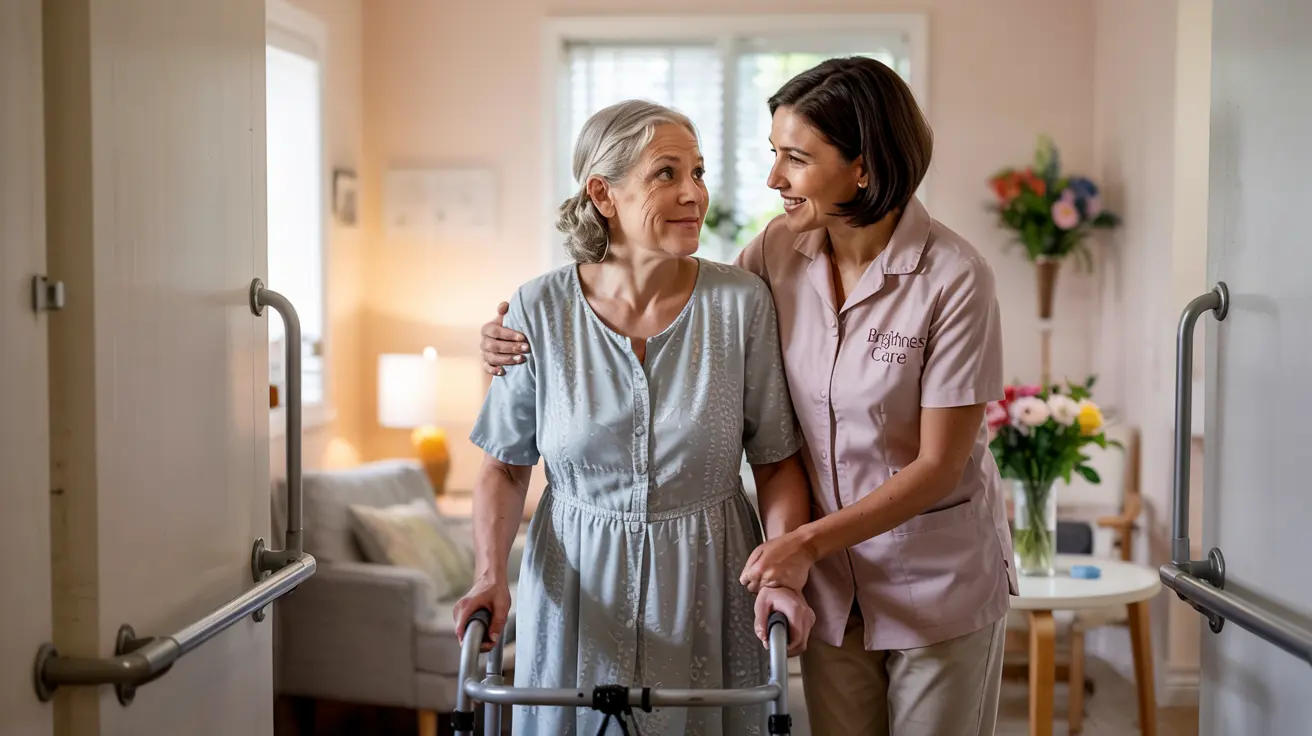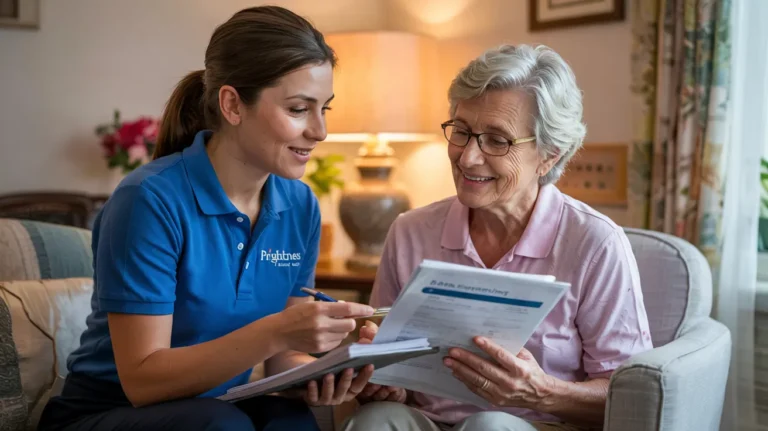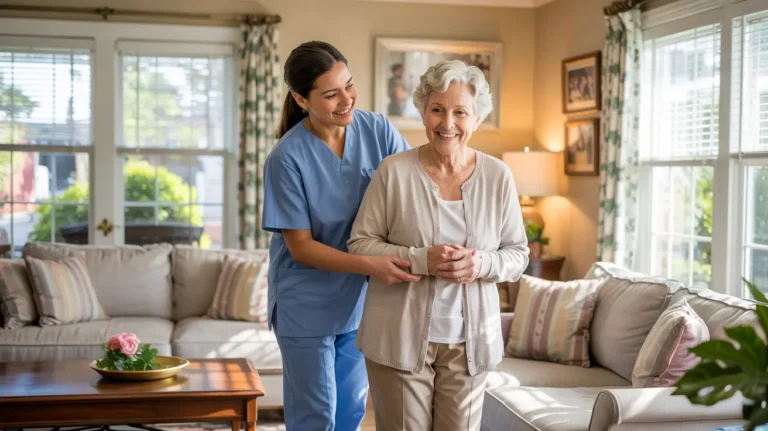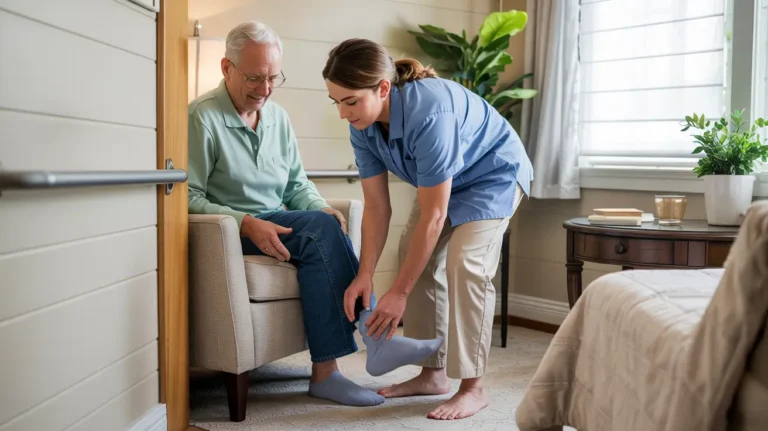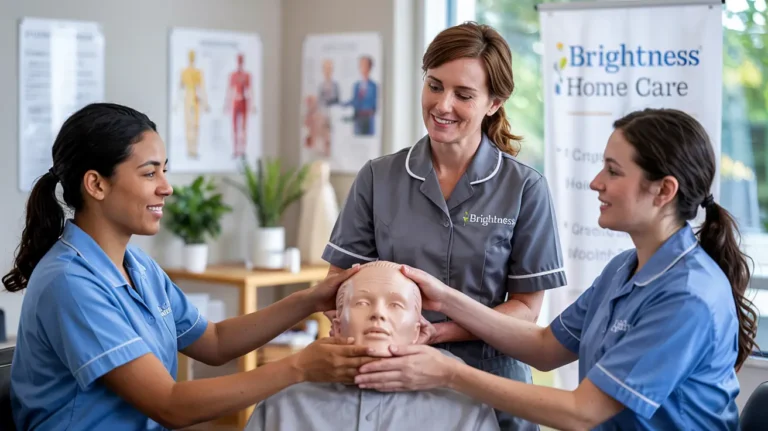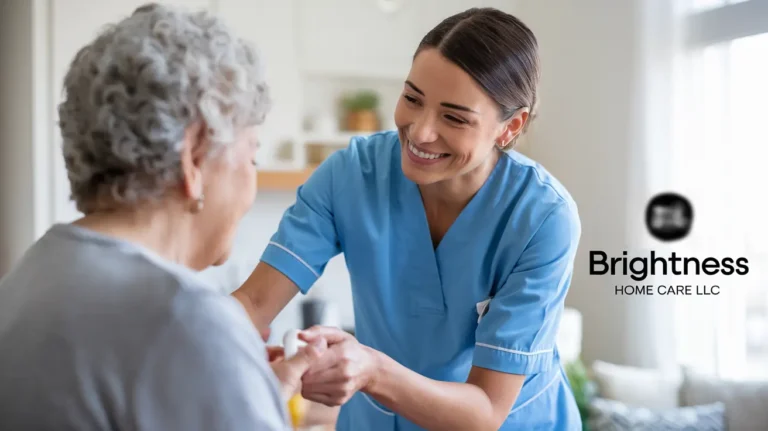Limited Mobility Care: How We Support Independence at Home in Indianapolis
I never thought I’d become so passionate about mobility care until I witnessed my first transformation. There was this client – let’s call her Eleanor – who had practically become a prisoner in her own bedroom after a bad fall. When we first met, she was convinced her independent days were over. Fast forward six months, and she was hosting bridge club in her living room again! That’s the kind of difference proper mobility support can make, and why I’m so driven to share what I’ve learned.
Limited mobility doesn’t have to mean limited life! But man, the challenges can seem overwhelming at first. Whether it’s from aging joints, recovering from surgery, or managing a progressive condition, mobility limitations affect everything from basic self-care to social connections. That’s why having the right support system is absolutely crucial.
Here at Brightness Home Care LLC in Indianapolis, we’ve developed a comprehensive approach to limited mobility care that focuses on maximizing independence while ensuring safety. Located at 4911 West 38th Street, our team has worked with hundreds of Indianapolis residents facing mobility challenges, and we’ve seen firsthand how the right support can transform lives.
In this article, I’ll walk you through everything you need to know about limited mobility care – from understanding the challenges and available services to home modifications and finding the right provider. Trust me, I’ve made plenty of mistakes along the way so you don’t have to! Let’s dive into how proper mobility support can help you or your loved one maintain independence and quality of life right here in Indianapolis.
Understanding Limited Mobility Challenges in Indianapolis
You know, I never truly understood the impact of limited mobility until I started working with clients here in Indianapolis. The look in someone’s eyes when they can’t get up from their favorite chair without help – it’s something that sticks with you. I’ve seen it time and again in our community.
Limited mobility isn’t just a physical challenge – it’s emotional too. In Indianapolis, we see mobility issues stemming from all sorts of causes. Sometimes it’s the natural aging process (aren’t we all feeling those knees a bit more each year?), but often it’s due to chronic conditions like arthritis, neurological disorders, or recovery from surgeries and injuries.
I remember working with a client on the north side who had lived independently for decades. After a hip fracture, she thought her independent life was over. Man, was that a tough conversation! But with the right support, she’s now moving around her home with confidence again. That’s what proper mobility care can do.
The numbers in Indianapolis are pretty eye-opening. With our growing senior population, mobility challenges are becoming increasingly common. About 40% of adults over 65 in our area report some form of mobility limitation that affects their daily activities. And honestly? That number keeps climbing.
What most folks don’t realize is how mobility limitations create this nasty domino effect. First, it’s difficult to get to the bathroom independently. Then, cooking becomes challenging. Soon, people stop going out entirely because it’s “just too much trouble.” I’ve watched clients slowly withdraw from activities they love, which can lead to isolation and depression. Not on my watch!
Physical limitations affect every aspect of daily life. Simple tasks most of us take for granted – grabbing a cup from the cabinet, getting the mail, or taking a shower – suddenly become monumental challenges. And the fear of falling? It’s constant. I’ve had clients tell me they’ve spent hours on the floor after a fall because they couldn’t reach a phone. Heartbreaking stuff.
The good news? I’ve learned that with appropriate support, most people with mobility challenges can maintain significant independence. The key is personalized care that addresses specific mobility needs. Here in Indianapolis, we’re fortunate to have resources available, though many families don’t know where to start looking.
Weather in Indianapolis doesn’t help matters either! Those icy winters make mobility even more treacherous for folks who are already unsteady. And our hot, humid summers can exacerbate joint pain for those with arthritis. I always tell my clients we need different strategies for different seasons.
The impact extends to caregivers too. Family members often injure themselves trying to help loved ones with mobility issues. I can’t tell you how many times I’ve worked with families where an adult child has thrown out their back trying to help Mom or Dad up from a chair. Proper techniques and equipment make all the difference.
At the end of the day, understanding mobility challenges means recognizing that they’re complex and unique to each person. What works for one client might not work for another. That’s why assessment and personalized care plans are so crucial.
Comprehensive Limited Mobility Care Services
Let me tell you, providing mobility care isn’t just about helping someone walk! I learned that lesson the hard way when I first started working with clients with limited mobility in Indianapolis. I thought I knew what I was doing until Mrs. Johnson (not her real name, of course) patiently explained that she didn’t need me hovering over her – she needed specific support that preserved her dignity and independence.
At Brightness Home Care, we’ve developed mobility assistance programs that are truly personalized. I work with each client to understand exactly what they can do independently and where they need support. Some days are better than others, right? Flexibility is key when supporting someone with arthritis or Parkinson’s, where mobility can fluctuate day to day.
Transfer assistance is probably one of the most important services we provide. Moving from bed to chair, chair to toilet, or in and out of the shower – these transitions can be particularly challenging and dangerous. I remember one client who’d been using a towel rack to pull himself up from the toilet – an accident waiting to happen! We implemented proper transfer techniques, and his risk of falling decreased dramatically.
Our approach to walking support varies based on each person’s needs. Sometimes it’s offering an arm for balance, other times it’s bringing the walker and positioning it correctly, or providing standby assistance as clients navigate their homes. I’ve found that many clients can walk independently once they’re up and stable – they just need help with that initial movement.
Fall prevention is something I’m particularly passionate about. After seeing a neighbor spend months recovering from a hip fracture after a preventable fall, I became obsessed with creating safer environments. We conduct thorough home assessments, looking for trip hazards like loose rugs, poor lighting, or cluttered walkways. Simple changes can make such a difference!
Daily living activities often become complicated with mobility limitations. Dressing can be frustrating – especially putting on socks or shoes. I’ve worked with clients on adaptive techniques and equipment like sock aids and long-handled shoe horns. Bathing becomes safer with grab bars and shower seats. Meal preparation is adapted with seated workstations and accessible kitchen organization.
Transportation to medical appointments presents huge challenges for Indianapolis residents with limited mobility. I’ve helped clients navigate the logistics of special transportation services, accessibility requirements, and timing medications for optimal mobility during appointments. Sometimes it’s as simple as having someone steady them from the car to the doctor’s office door.
One thing that surprised me when I started this work was how much emotional support is involved. Limited mobility often comes with grief over lost independence. I’ve sat with clients who just needed to express frustration before we could move forward with physical assistance. That human connection is just as important as the hands-on help.
Coordination with healthcare providers has proven invaluable for optimal mobility support. When we understand a client’s physical therapy goals, we can reinforce those same movements during daily care. I’ve seen remarkable improvements when home care and medical care work hand-in-hand.
Here in Indianapolis, seasonal considerations impact our mobility care services too. During winter, we might focus more on indoor exercises and safe entry/exit procedures. In summer, we can incorporate more outdoor walking to strengthen muscles and enjoy fresh air.
Every mobility care plan we create at Brightness Home Care is living and breathing – it changes as our clients’ needs change. That’s the beauty of personalized care.
Home Modifications for Enhanced Mobility
I’ll never forget the time I walked into a client’s home in Indianapolis and immediately spotted at least seven fall hazards in the living room alone. Throw rugs that would slip, electrical cords snaking across walkways, poor lighting, and furniture arranged in a way that created an obstacle course. The sweet lady living there had already fallen twice but never thought her home setup might be contributing to the problem!
Home modifications don’t always have to be expensive or dramatic renovations. Sometimes it’s the simple changes that make the biggest difference. I’ve seen clients transformed by something as basic as rearranging furniture to create wider pathways or installing brighter lightbulbs in hallways and stairwells.
When I visit a new client’s home, I typically start with a room-by-room assessment. The bathroom is usually ground zero for mobility challenges. Those slippery tile floors have caused more falls than I care to count! Installing grab bars beside the toilet and in the shower can be literal lifesavers. I remember one gentleman who resisted grab bars because they looked “too institutional” until we found some that matched his bathroom fixtures perfectly. Now he wonders how he ever managed without them!
The bedroom presents its own set of challenges. Beds that are too high or too low make transfers difficult. I’ve advised clients to add bed risers or remove box springs depending on their needs. Nightstands within easy reach can prevent dangerous stretching in the middle of the night. And those bedside lamps with touch sensors? Game changers for folks with limited dexterity!
Kitchens require thoughtful reorganization for someone with mobility limitations. I often recommend moving frequently used items to cabinets between waist and shoulder height. Pull-out shelving in lower cabinets eliminates the need to bend and reach. One creative solution I’ve implemented is setting up a seated workstation where clients can prep food while conserving energy and maintaining balance.
Stairways present significant obstacles for many Indianapolis homes. Not everyone can afford a stairlift (though they’re fabulous when feasible), but adding a second handrail on the opposite wall can make stairs much safer. I also recommend high-contrast tape on stair edges to improve visibility and reduce tripping.
Doorways can be problematic for those using walkers or wheelchairs. Standard doorways are often too narrow, and thresholds create tripping hazards. Offset hinges are an affordable solution that can add a couple of crucial inches to doorway width without major construction. And those rubber threshold ramps? Worth their weight in gold for wheelchair users!
I’ve learned that funding resources exist for many home modifications in Indianapolis, though they’re not always well-publicized. The CHOICE program through Indiana’s Division of Aging can help cover some modification costs. Organizations like Rebuilding Together Indianapolis sometimes provide volunteer labor for seniors and people with disabilities. Local occupational therapy programs occasionally take on home modification projects as student training opportunities.
The changes we make aren’t just about safety – they’re about preserving independence and dignity. I’ve seen the pride in clients’ eyes when they can navigate their own homes without calling for help. One woman cried tears of joy when she could finally make her own cup of tea after we modified her kitchen.
Our caregivers at Brightness Home Care are trained to work effectively within modified environments. We understand how to properly use transfer benches, bed rails, and other adaptive equipment. Sometimes we identify new modification needs as care progresses – it’s an ongoing process of assessment and adjustment.
The best modifications balance safety with maintaining the comfort and character of someone’s home. Nobody wants to feel like they’re living in a hospital. With thoughtful planning and the right resources, most Indianapolis homes can become mobility-friendly without sacrificing warmth and personality.
The Brightness Home Care Approach to Mobility Support
When I first started working with clients with limited mobility, I made a rookie mistake. I tried to do too much for them. I’d swoop in and take over tasks they could do partly or slowly on their own. Not only did this frustrate my clients (rightfully so!), but it actually contributed to declining mobility over time. That’s when I realized supporting mobility isn’t about taking over – it’s about enabling independence through just the right amount of assistance.
This realization has become central to our philosophy at Brightness Home Care. We believe in the “just enough” approach to mobility assistance. This means providing exactly the level of support needed – no more, no less – and adjusting that support as abilities fluctuate. For some clients, that might mean standby assistance as they navigate their morning routine. For others, it might mean more hands-on help with transfers and positioning.
Our caregivers go through extensive mobility support training before ever working with clients. They learn proper body mechanics to prevent injuries to both themselves and clients. They practice transfer techniques for different scenarios – bed to chair, chair to toilet, car to standing. They learn to recognize signs of fatigue or pain that might indicate a need for increased assistance. This training is refreshed regularly as techniques evolve.
I remember one particular client who had given up on walking altogether after a stroke. His family assumed he’d be wheelchair-bound permanently. During our initial assessment, I noticed he had some untapped strength and balance potential. We started with minimal standing exercises, progressed to short walks with substantial support, and gradually increased distance while decreasing assistance. Six months later, he was walking to the mailbox with just a cane! His doctor was amazed at the progress.
Our mobility assessment process is thorough and personalized. We evaluate strength, balance, coordination, and endurance. We note any pain points or areas of concern. We observe current mobility patterns and compensatory movements that might increase fall risk. Most importantly, we talk with clients about their mobility goals. What activities matter most to them? Where do they want to regain independence?
Collaboration with healthcare providers is essential to our approach. We maintain regular communication with physical therapists to ensure we’re reinforcing the same techniques they’re teaching. We coordinate with doctors about medication timing that might affect mobility throughout the day. We provide feedback about mobility changes that might indicate the need for medical intervention or equipment adjustments.
Speaking of equipment – we help clients navigate the sometimes overwhelming world of mobility aids. From selecting the right cane height to determining whether a front-wheeled or four-wheeled walker is more appropriate, these details matter tremendously. I’ve seen clients struggle unnecessarily with ill-fitting equipment that actually created new mobility problems!
The success stories from our Indianapolis clients keep us motivated every day. There was the retired teacher who regained enough mobility to attend her granddaughter’s school play after months of consistent support. The former gardener who, with adapted techniques and the right assistance, returned to tending his beloved tomato plants. The widow who feared she’d never dance again but managed a slow waltz at her son’s wedding with subtle support from her caregiver.
Our approach isn’t just physical – it’s psychological too. Fear of falling creates tension and unnatural movement patterns that ironically increase fall risk. We work with clients to build confidence through successful mobility experiences in controlled environments before tackling more challenging situations.
At Brightness Home Care, located right here at 4911 West 38th Street in Indianapolis, we see mobility support as a dynamic partnership that evolves with our clients’ changing needs. Some days require more assistance than others, and that’s perfectly okay. The goal remains constant: maximizing independence while ensuring safety.
Maintaining Independence Despite Mobility Limitations
You know what? One of the biggest misconceptions I’ve encountered is that limited mobility automatically means limited independence. Nothing could be further from the truth! I learned this lesson when working with a former school principal in Indianapolis who refused to let her progressing MS define her capabilities. “Adaptation isn’t giving up,” she told me, “it’s being smart about how I use my energy.” Her words have stuck with me through years of supporting clients with mobility challenges.
The psychological impact of mobility limitations can sometimes be harder to address than the physical aspects. I’ve sat with clients as they processed feelings of frustration, grief, and sometimes shame about needing assistance. One gentleman I worked with would apologize constantly when I helped him transfer from his wheelchair – until we had a heart-to-heart about how accepting help is actually a form of strength. Changing that mindset made such a difference in his quality of life!
Technology has been a game-changer for maintaining independence. Voice-activated systems like Alexa or Google Home allow clients to control lights, temperature, and even make calls without physical movement. I helped one woman set up her smart home system, and she tearfully explained how empowering it felt to manage her environment independently again. Practical tools like reacher-grabbers, button hooks, and electric can openers also make daily tasks possible without assistance.
Indianapolis has some fantastic community resources for mobility support that many people don’t know about. The public library offers home delivery services for book lovers with limited mobility. Several grocery stores provide delivery with minimal fees. Transportation services like IndyGo’s Open Door paratransit help clients maintain social connections. I’ve connected countless clients with these services, watching their worlds expand beyond their four walls.
Adapting activities to accommodate mobility limitations doesn’t mean giving them up entirely. I worked with an avid gardener who thought her hobby was over after developing severe arthritis. We created raised beds at wheelchair height, found ergonomic tools, and modified techniques. The joy on her face when she harvested her first tomatoes that season – priceless! Whether it’s crafting, cooking, or socializing, almost any activity can be adapted.
Building confidence through appropriate assistance levels takes patience and consistency. I start by identifying what a client can do completely independently, what they can do with minimal support, and what requires full assistance. Then we work on expanding those middle-ground activities. I remember a client who initially needed significant help getting dressed but gradually needed only setup assistance as his confidence grew. Those small victories lead to bigger ones!
Exercise adapted for limited mobility is crucial for maintaining and sometimes improving function. Seated tai chi, water therapy, and resistance band exercises can be game-changers. I’ve incorporated simple movements into daily routines – leg lifts while watching TV, shoulder rolls while waiting for the kettle to boil. One client jokingly calls it “sneaky exercise” because it doesn’t feel like a formal workout.
Maintaining social connections can be challenging with mobility limitations, but it’s essential for emotional wellbeing. I’ve helped clients set up video calls with family, arranged transportation to community events, and sometimes just provided the confidence boost needed to accept social invitations. The pandemic actually improved some options here – many Indianapolis community groups now offer hybrid meetings where people can participate virtually.
Nutrition plays a surprisingly important role in mobility independence. Proper hydration and balanced nutrition support muscle function and energy levels. I’ve worked with clients to set up meal prep systems that require minimal standing, arranged for grocery delivery services, and found kitchen tools that accommodate hand weakness or tremors. Something as simple as a good water bottle with a straw can help maintain hydration without assistance.
Environmental modifications continue to evolve as mobility changes. What works one month might need adjustment the next. I check in regularly with clients about which tasks are becoming more challenging and brainstorm solutions. Sometimes it’s as simple as moving a frequently used item to a lower shelf or adding a chair in a strategic location for rest breaks.
The clients who maintain the most independence share a common trait: they’re willing to accept help with certain tasks to conserve energy for activities that matter most to them. It’s not about doing everything independently – it’s about making intentional choices that maximize quality of life. That’s the balance we strive for at Brightness Home Care.
Finding the Right Mobility Care Provider in Indianapolis
Finding the right mobility care provider can feel overwhelming – I know because I’ve been on both sides of this equation. Before joining Brightness Home Care, I helped my own father navigate this process after his Parkinson’s diagnosis. We made some mistakes along the way that I now help other families avoid.
When looking for mobility support in Indianapolis, start by making a list of your specific needs. Do you need help with transfers? Assistance with personal care? Support for community outings? The more specific you can be, the better your chances of finding the right match. I’ve seen families rush into care arrangements only to discover the provider doesn’t have experience with their particular mobility challenges.
The questions you ask potential care providers reveal a lot about their expertise. I suggest asking: “What specific training do your caregivers receive for mobility assistance?” “How do you handle emergencies like falls?” “Can you provide references from clients with similar mobility issues?” The answers should demonstrate both knowledge and experience with your specific concerns.
Caregiver qualifications matter tremendously when it comes to mobility support. Look for providers whose staff have training in transfer techniques, fall prevention, and proper body mechanics. At Brightness Home Care, all our team members complete hands-on training in safe mobility assistance before ever working with clients. I remember one family who hired the lowest-cost provider they could find, only to switch to us after multiple unsafe transfers that scared both the client and caregiver.
Insurance and payment considerations often factor into care decisions. Traditional Medicare typically doesn’t cover long-term home care for mobility issues, though Medicare Advantage plans sometimes offer limited benefits. Long-term care insurance usually covers these services, but policies vary widely. Indiana Medicaid’s Aged & Disabled Waiver can help eligible Indianapolis residents access care services. I’ve helped numerous families navigate these complex systems to find affordable care solutions.
Evaluating if a care provider is the right fit goes beyond just credentials and costs. The relationship between caregiver and client is incredibly important. I always recommend a meet-and-greet before committing to services. Do you feel comfortable with this person? Do they listen carefully to your preferences? Do they approach mobility challenges with respect for your independence? Trust your instincts here!
Local expertise matters tremendously for Indianapolis residents. A provider familiar with our community can connect you with valuable local resources like support groups, specialty medical providers, and adaptive equipment vendors. They’ll understand how to navigate our city’s transportation options and seasonal challenges. When my dad needed care, we initially chose a national chain only to switch to a local provider who had relationships with the exact specialists he needed.
The care coordinator’s role can’t be overlooked when selecting a mobility provider. This person will be your main point of contact for adjusting care plans, addressing concerns, and coordinating with healthcare providers. At Brightness Home Care, our care coordinators make regular home visits to ensure mobility needs are being properly addressed as conditions change.
Consistency in caregivers is particularly important for mobility support. Each caregiver has slightly different techniques, and these subtle differences can be confusing or even risky for someone with limited mobility. Look for providers who prioritize consistent staffing. I’ve worked with clients who previously had different caregivers every day, causing anxiety about transfers and mobility assistance.
Don’t overlook the importance of emergency protocols when choosing a provider. What happens if a caregiver arrives to find you’ve fallen? What backup systems are in place if a caregiver can’t make it during severe Indianapolis weather? Comprehensive providers have clear protocols for various scenarios.
At Brightness Home Care, located at 4911 West 38th Street in Indianapolis, we believe finding the right mobility care provider isn’t just about physical support – it’s about finding partners in maintaining your independence and quality of life. The right provider sees the person first, not just the mobility limitation.
Conclusion
When it comes down to it, limited mobility care is about so much more than physical assistance – it’s about preserving dignity, independence, and joy in everyday life. Throughout my years working with clients across Indianapolis, I’ve seen the profound difference that thoughtful, personalized mobility support can make. From the gentleman who danced at his grandson’s wedding to the avid gardener who reclaimed her beloved hobby, these success stories keep me passionate about this work.
The journey with mobility challenges is rarely a straight line. Some days are better than others, and needs evolve over time. That’s why flexibility and ongoing assessment are so important in any mobility care plan. What works today might need adjustment tomorrow, and that’s completely normal! The key is having a care partner who understands this dynamic nature and adapts accordingly.
I want to emphasize that safety should never be compromised while supporting independence. Every decision about mobility assistance involves balancing these two crucial factors. Sometimes this means accepting help with certain activities to conserve energy for the things that matter most to you. Remember, accepting support isn’t giving up – it’s making smart choices about how you use your resources!
Here at Brightness Home Care LLC in Indianapolis, we’re committed to providing mobility support that enhances quality of life while respecting individual preferences and goals. Our team understands the unique challenges facing Indianapolis residents with mobility limitations, from navigating our sometimes extreme weather to connecting with community resources that can expand your world beyond your doorstep.
If you or a loved one are facing mobility challenges, I encourage you to reach out for a consultation. Every situation is unique, and we’d love to discuss how our approach might benefit your specific circumstances. You deserve care that sees the whole person – not just the mobility limitation.
I’d love to hear about your experiences with mobility challenges or care. What strategies have worked well for you? What resources have you found helpful in the Indianapolis area? Sharing these insights helps our entire community support each other better!
Remember, limited mobility may change how you do things, but with the right support, it doesn’t have to change what you do. Independence is possible – sometimes it just looks a little different than before.

